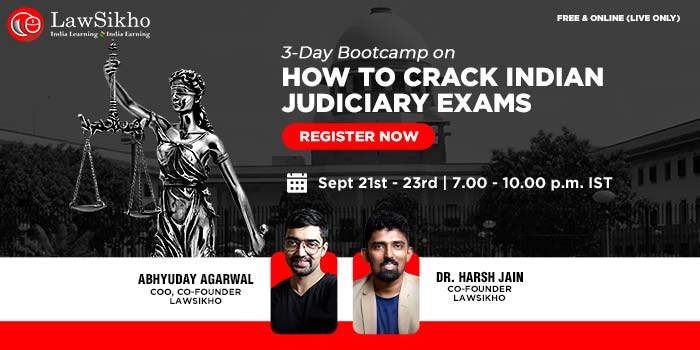This article has been written by Ria Verma and further updated by Shefali Chitkara. This article aims to analyse the landmark judgement of Bachan Singh v. Union of India and its aftermath. The author has tried to give a brief overview and background of the judgement, with a focus on the need, relevance, and limitations of the ‘rarest of rare doctrine’ that was formulated by the Hon’ble Court in this case. Further, the author has mentioned the key highlights of the judgement, including a note on aggravating and mitigating circumstances, the reform test, and the 35th Report of the Law Commission of India. The author has also tried to explore key judgements on the death penalty over the years.
Table of Contents
Introduction
Recently, a 38-year old man was convicted for killing his mother and attempting to kill his neighbour as well. The Court considered the case to be ‘rarest of the rare’ and awarded him the death penalty. Another man was awarded the death penalty for committing the gruesome act of raping a minor girl and then killing her.
Capital punishment has been a topic of discourse since its inception. Would hanging the culprit justify their actions? Would there be deterrence in society, and would the number of crimes be reduced? The answers to these questions are ambiguous.
Bachan Singh v. State of Punjab (1980) is a well-known and landmark judgement credited with developing the jurisprudence on the death penalty. It answered the constitutional validity of the death penalty and examined whether it was in consonance with the Articles of the Indian Constitution.
This case addressed the issue of whether the procedure given under Section 354(3) of the Code of Criminal Procedure, 1973 (hereinafter referred to as “CrPC”) pertaining to sentencing the convicted person is unconstitutional. The courts are given unguided discretion, and it is completely in their hands to decide whether the death penalty should be awarded or not.
This case has been widely regarded as a landmark judgement given by a bench consisting of five judges and is known for establishing the “rarest of the rare” doctrine applicable while deciding whether the death penalty is to be imposed on the accused.
We need to address the question of whether, 44 years after the judgement, the court successfully created a coherent basis for imposing the death penalty in India.
In the present case, the accused, Bachan Singh, was convicted for the murder of two persons and was given the death sentence by the Sessions Judge, which was upheld by the Punjab and Haryana High Court. This decision was further appealed but dismissed by the Supreme Court of India. The death penalty has always been a topic of debate, and this case stands as a landmark in Indian criminal law. It addressed the constitutionality of the death penalty, established the importance of considering aggravating and mitigating circumstances, and introduced the guiding principle of the ‘rarest of rare doctrine’. This judgement has had a significant impact on the sentencing process in death penalty cases, aiming to maintain a balance between justice and the fundamental rights of convicted persons.
What is this rarest of the rare doctrine and under what circumstances can the Court impose the death penalty upon a convicted person? Let us try to find an answer for the same.
History of death penalty
In earlier times, the punishments for criminals included boiling to death, crucifixion, crushing, stoning, and flaying. The death penalty was imposed for various reasons that today would seem barbaric. The history of the death penalty, or capital punishment, is long and can be traced back to the code of Hammurabi. In the Eighteenth Century B.C., it codified the death penalty for twenty-five different offences. Mention of the death penalty is also found in the Fourteenth Century B.C.’s Hittite Code and the Seventh Century B.C.’s Draconian Code of Athens. In Britain, when capital crimes increased, around 222 crimes were made punishable by death, including stealing. Later, this led to reforms in Britain’s death penalty laws, resulting in the removal of capital punishment for 100 of the 222 offences.
The British were the first to set up a centralised government over the whole country, and their law prescribed death sentences for twelve offences. Influenced by them, the Indian Penal Code (hereinafter referred to as “IPC”) came into force in 1862, incorporating the English tradition of capital punishment in a codified form.
Death penalty in India
In India, the death penalty is imposed in cases of murder, gang robbery coupled with murder, abetting the suicide of an insane person, a minor, abetting a mutiny by a member of the armed forces, and waging war against the government. Capital punishment is also awarded under anti-terror laws for those who have a significant involvement in committing terrorist acts.
The general approach of the courts is to award the death penalty to the convicts in a murder case. As per the facts and circumstances of the case, it is scrutinised whether the case would fall under the ambit of ‘rarest of the rare’ cases.
India is thus one of those countries that retains the death penalty within its legal framework for the rarest of the rare crimes, and yet it is not in favour of abolishing it completely. The death penalty is the execution of a convicted person under a death sentence imposed by a competent authority. It is also referred to as ‘capital punishment’. The word ‘capital’ is derived from the Latin word ‘capitalis’ which means ‘of the head’. The reason being that in ancient times, the death penalty was carried out by beheading a person. Capital punishment represents the maximum quantum of punishment permitted by law for a criminal in India. In the present case of Bachan Singh v. State of Punjab, the Supreme Court held that the death penalty must be imposed in the most heinous crimes where the doctrine of the rarest of rare case applies.
In the present scenario, where around 142 countries have abolished the death penalty, it remains a topic of debate in India. The argument often centres around the belief that life is a gift from God, and only he has the right to take it back. Although capital punishment can be imposed only in the ‘rarest of rare’ cases, it sparks concerns in a country that values human rights. How can capital punishment be justified when it seemingly violates fundamental human rights? Moreover, is the phrase ‘rarest of rare’ defined anywhere? The answer is negative, indicating that the ambiguity in this phrase can lead to judgments that are erroneous, as it is totally within the discretion of the judges deciding that case. Multiple considerations come into play before deciding if someone should face capital punishment.
India had not cast a vote in favour of the UN resolution that called for the abolition of capital punishment. The power to grant mercy in a case of the death penalty is with the president. If a convict is sentenced to death by the Sessions Court, it must be confirmed by the High Court. Subsequently, the convict has another option to appeal to the Supreme Court. If the appeal fails, then he may make a mercy petition to the president of India under Article 72 of the Indian Constitution. This Article grants the president the power to pardon, reprieve, or remission the punishment or reduce the sentence of a person who has been convicted of an offence.
The first person to be hanged in independent India in 1949 was Nathuram Godse in the case of Nathu Ram v. Godse v. The Crown (1949). Then, a terrorist, Afzal Guru, who attacked the Indian parliament in 2001, was executed in 2013 in the case of State v. Mohd. Afzal and Ors. (2003). A lone survivor of the Mumbai attack of 2008, Ajmal Kasab, was executed in 2012 in the case of Mohammad Ajmal Amir Kasab v. State of Maharashtra (2012). In 2020, in Mukesh and Anrs. v. NCT Delhi (2017), Nirbhaya convicts were also hanged after years of legal proceedings, highlighting the data on delayed executions in death penalty cases in India.
However, amidst these considerations, a stark development emerges – the death row population in India reached 561 prisoners by the end of 2023, the highest since 2004. In an unexpected turn, the Supreme Court acquitted nearly 55% of these individuals during its 2023 hearing, signalling a notable departure from traditional trends. This shift raises crucial questions as to where India is heading with its views on the death penalty.
The situation gains added importance when we consider a step taken by the Court in September 2022. They decided to form a special bench to look into how death penalties are given. But, given the persistent problems with how sentences are decided in India’s courts, it’s not clear if this panel can actually bring about significant improvements.
Instead, when we see more and more people being acquitted and the number of people on death row increasing rapidly, it makes us question whether the Court should not only focus on how sentences are decided but also rethink the whole system of reforming the death penalty in India.
Offences punishable with death sentence
The Indian Penal Code specifically and other statutes also provide for capital punishment as one of the punishments for rare crimes. In the IPC, these offences are made punishable with the death sentence:
- Waging war against the government (Section 121)
- Abetting mutiny when committed (Section 132)
- Giving or fabricating false evidence through which an innocent person suffers death (Section 194)
- Threatening any person to give false evidence, and if an innocent person is convicted in consequence (Section 195 A)
- Murder (Section 302)
- Abatement of suicide by a child or insane person (Section 305)
- Kidnapping for ransom (Section 364 A)
- Rape and causing death or resulting in the persistent vegetative state of the victim (Section 376 A)
- Rape on women under 12 years of age (Section 376 AB)
- Gang rape on women under 12 years of age (Section 376 DB)
- Punishment for repeat offenders in rape cases (Section 376 E)
- Dacoity with murder (Section 396)
The other statutes that provide for the death sentence are:
- Commission of Sati (Prevention) Act, 1987
- SC and ST (Prevention of Atrocities) Act, 1989
- Protection of Children from Sexual Offences Act (POCSO), 2012
- Narcotics, Drugs, and Psychotropic Substances Act, 1985
- Unlawful Activities (Prevention) Act, 1967
- Army Act, 1950
- The Navy Act, 1957
- The Air Force Act, 1950
Section 354(3) of the Code of Criminal Procedure
Section 354 of the CrPC, which was added to the Code in 1973, mandates judges to provide specific justifications when imposing the death penalty.
Adding nuance to this, Section 354(3) emphasises that judges must provide reasons for any sentence that is awarded and offer ‘special reasons’ when the convict is punished with the death penalty.
The sentencing follows conviction and is proportional to the degree and intensity of the crime committed. However, no straitjacket formula is applicable while sentencing the convicts.
Background of Bachan Singh v. State of Punjab (1980)
There were quite a few judicial pronouncements before the Court gave the judgement in Bachan Singh regarding whether the death penalty is in lieu of constitutional provisions.
In Jagmohan Singh v. State of U.P. (1972), the Supreme Court held that the death penalty did not violate Articles 14, 19, and 21 that guarantee the right to equality, freedom of speech and expression, and the right to life. The facts, circumstances, and nature of the crime committed would be the factors scrutinised by the judge when making the choice between awarding the death penalty or life imprisonment. Therefore, the decision to award the death penalty was made according to the procedure that has been laid down by law under Article 21.
In Rajendra Prasad v. State of U.P. (1979), the Court held that unless it was shown that the individual is a terrible and continuing threat to social security, capital punishment would not be justified. Justice Krishna Iyer opined that the death penalty should be inflicted in the case of three categories of criminals:
- for white-collar offences,
- for social offences, and
- for eradicating a person who is a threat to society, that is, a seasoned killer.
The Court also held that the death penalty for the offence of murder, which is awarded pursuant to Section 302 of the IPC, 1860, would not be a violation of the constitutional provisions. In grave cases of extreme culpability, capital punishment can be awarded, and the convict’s condition must be taken into consideration.
Provisions involved in the case
- Section 354 (3) of the CrPC, 1973.
- Section 302 of the IPC, 1860.
- Articles 14 and 21 of the Constitution.
Facts of Bachan Singh v. State of Punjab (1980)
Having previously been convicted for the murder of his wife under Section 302 of the IPC, Bachan Singh served 14 years in prison. After his release, he resided with his cousin, Hukum Singh, and his family. However, this living arrangement was objected to by the wife and children of his cousin. On July 4, 1977, the appellant committed an atrocious act by murdering three out of four children of his cousin using an axe.
Bachan Singh was thus convicted for the offence of committing the murder of Desa Singh, Durga Bai, and Veeran Bai by the Sessions Court. He was given the death penalty under Section 302 of the IPC. He appealed to the High Court; however, the Court dismissed his appeal and upheld the death sentence.
He then appealed to the Supreme Court and raised the question of whether the facts of the case would fall under the ambit of the ‘special reasons’ under Section 354(3) of CrPC, 1973.
Prominent issues raised
- Whether the death penalty that has been provided as the punishment for the offence of murder under Section 302, Indian Penal Code, 1860, is unconstitutional?
- Whether the sentencing procedure stipulated in Section 354(3) of the CrPC, 1973, is unconstitutional insofar as it vests the courts with unguided and untrampled power and allows the death sentence to be imposed arbitrarily on an individual found guilty of any offence punishable with death or life imprisonment?
Contentions of the petitioner
The petitioner raised the contention that the death penalty awarded for the offence of murder mentioned under Section 302 of the IPC violates Article 19 of the Indian Constitution. The death penalty puts an end to all the freedoms guaranteed under Article 19(a) to (g). No social purpose is served by the death penalty, and it does not fall under the purview of unreasonable restriction.
The petitioner relied on the doctrine of proportionality and contended that the death penalty in this case is an extreme punishment and should only be imposed in the rarest of the rare cases where imprisonment for life is considered inadequate. The counsel also referred to the Rajendra Prasad case to emphasise the importance of the rarest of the rare doctrine. Imposing the death penalty unnecessarily would infringe upon the fundamental rights of the accused person under Article 21 of the Indian Constitution. Thus, he demands a stringent standard of interpretation.
Contentions of the respondents
The respondents contended that an individual must own property in a way that does not infringe the rights of another individual, that is, the principle of sic utere tuo ut alienum non laedas. They further contended that the rights guaranteed under Article 19 are not absolute in nature and are subject to certain reasonable restrictions.
The counsel for respondents argued that the death penalty serves as a powerful deterrent for the people, preventing them from committing heinous crimes and instilling fear in potential criminals. They also argued that judges have the discretion to impose any penalty depending on the facts and circumstances of each case to promote justice. The respondents further asserted that special reasons in this particular case justified the imposition of the death penalty, considering the past conduct of the convicted person. As per the respondents, the death penalty was rightly imposed on the convicted person, according to the established precedents and the authority of the Constitution of India.
Judgment in Bachan Singh v. State of Punjab (1980)
The Supreme Court, with the majority opinion, had dismissed the appeal. The Court dismissed the challenge to the constitutionality of Section 302 of the IPC in so far as it prescribed the death penalty as one of the punishments, as well as the constitutionality of Section 354(3) of the CrPC, 1973.
The Court stated that the provision of the death sentence is only an alternative to other punishments prescribed for murder under Section 302 of the IPC, 1860, and cannot be considered unreasonable and not in the public interest since the Parliament had already taken this into consideration while revising the Code of 1898, eventually replacing it with the CrPC, 1973. The Court did not hold the sentence of death penalty as unconstitutional but established the doctrine of the ‘rarest of the rare’, wherein only cases falling under rarest of rare category could be punished with a death sentence, and that too only after the courts provide special reasons for such punishment.
The Court also laid down the aggravating and mitigating circumstances that must be considered by the judges while granting a death sentence to any convicted person, emphasising the need to assign proportionate weight to both elements.
Section 302 of the IPC, 1860, and Section 354(3) of the CrPC were held to be constitutional and not violative of Articles 14, 19, and 21 of the Indian Constitution.
Analysis of the judgement in Bachan Singh v. State of Punjab (1980)
In the landmark judgement of Maneka Gandhi v. Union of India (1978), the scope and the interrelationship between Articles 14, 19, and 21 were given a new dimension. It was held that every law of punitive detention must pass the test of all three articles, both from a procedural and substantive angle.
In A.K. Gopalan v. The State of Madras (1950), all six learned judges were of the opinion that if the accused was awarded punitive detention or imprisonment after being convicted of committing an offence under the Indian Penal Code, it would be beyond the scope of Article 19.
The Supreme Court dismissed the challenges regarding the constitutionality of Section 302 of the IPC and 354(3) of the CrPc. The Court further opined that the six fundamental rights given under Article 19(1) are not absolute in nature.
Firstly, they are subject to restrictions emanating from an obligation of an individual to not use their rights in a way that injures or infringes on the rights of other members of society. This is based on the maxim sic utere tuo ut alienum non laedas, that is, an individual using their property in a manner that does not infringe the legal rights of another individual.
Secondly, under Clauses (2) to (6) of Article 19, these rights are expressly mentioned as being subject to the power of the state, which can impose certain reasonable restrictions. These restrictions could extend to prohibiting the exercise of these rights in special circumstances.
Another issue is whether the courts have untrampled power in imposing the death penalty and the nature and extent of the special reasons. The expression ‘special reasons’ as stated in Section 354(3) of the CrPC means exceptional reasons owing to the grave nature of the crime. The Apex Court laid down the doctrine of ‘rarest of the rare cases’ for imposing the death sentence. Life imprisonment is the rule, and the death sentence is awarded as an exception for those convicted of murder. Exercise of discretion under Section 354(3) of the CrPC, 1973, would be exceptional. The death penalty would be awarded only for crimes that shake the collective conscience of society. The imposition of the death sentence should only be in the rarest of rare cases.

The Court also referred to the foreign judgments while delivering the judgement in the present case. In the case of Furman v. Georgia (1972), the death penalty was held to be unconstitutional by the US Supreme Court for violating the 8th Amendment, which prohibits cruel punishments. However, in the present case, the Supreme Court of India rejected the reasoning of the aforementioned decision. Subsequently, in Gregg v. Georgia (1976), the constitutional validity of the death penalty was upheld by the US Supreme Court, and the Court had established a set of guidelines for its imposition. In the present case, the Supreme Court used these guidelines to develop its own criteria for determining whether the death penalty should be imposed or not.
Further, Justice Sarkaria stated the following points in the judgement:
- The extreme death penalty can be inflicted in the gravest cases of extreme culpability.
- Along with the facts and circumstances of the offence, the circumstances of the offender must be taken into account. The court must scrutinise both the crime as well as the criminal, and then decide whether life imprisonment is to be awarded or the death penalty. Accordingly, the presence or absence of ‘special reasons’ must be established. The emphasis is to be laid on the aggravating and mitigating factors, which are dependent upon the facts and circumstances of the case.
A few parameters were suggested by Dr. Chatale in the judgement for ascertaining ‘aggravating circumstances’. He drew inferences from the American penal statutes framed after Furman v. Georgia (1972), in general, and Clauses 2(a), (b), (c), and (d) of the Indian Penal Code (Amendment) Bill that was passed in 1978 by the Rajya Sabha (but was not ultimately enacted). The parameters are as follows:
- The murder was premeditated and involved extreme brutality;
- The murder involves exceptional depravity; or
- A member of any of the armed forces of the Union, or a member of any police force, or any public servant was murdered while the member or public servant was discharging their duties;
- The public servant was discharging their duty; or in consequence of anything done or attempted to be done by such a public servant during the lawful discharge of their duty as such a public servant, whether at the time of the murder he was such a public servant or had ceased to be such a public servant; or
- If the murder is of a person who had acted in the lawful discharge of his duty under Section 43 of the CrPC, 1973, or who had assisted a magistrate or a police officer demanding his aid or requiring his assistance under Section 37 and Section 129 of the said Code.
He further suggested a few mitigating circumstances that the Court should take into account as per their discretion:
- The offence was committed by an individual who was extremely mentally or emotionally disturbed.
- The age of the accused is to be taken into account. If the accused is a minor, he shall not be sentenced to death.
- The probability that the accused would not commit criminal acts of violence that would act as a threat to the well-being of the members of society.
- The probability that the accused can be reformed and rehabilitated. The state would need to prove that the accused does not fulfil these conditions by giving sufficient evidence.
- If the accused felt that he was morally justified in committing the act as per the facts and circumstances of the case.
- The accused acted under duress or was dominated by another individual’s will.
- The condition of the accused showed that he was mentally ill, and because of the illness, he was not capable of understanding the criminality of his conduct.
Dissenting opinion
The rule of law penetrates the entire fabric of the Indian Constitution. It does not include arbitrariness. Article 14 acts as a guarantee against arbitrariness and prohibits state action, whether legislative or executive, that suffers from a high level of arbitrariness.
Justice PN Bhagwati was of the view that Section 302 of the IPC, in so far as it provides for the imposition of the death penalty as an alternative to a life sentence, is ultra vires. It is unconstitutional and void since it is an infringement of Articles 14 and 21 of the Constitution, and no legislative guidelines are laid down as to when life should be permitted to be extinguished by the imposition of the death sentence.
Another dissenting opinion was that it is difficult to answer the question of whether the death penalty serves any penological purpose. It is a difficult, complex, and intractable issue. There has been significant discourse on the purposes of the death penalty and whether it serves the purpose of deterrence. A large proportion of people, including sociologists, legislators, jurists, judges, and administrators, from the length and breadth of the country as well as the world, still have averse opinions towards the necessity of imposing capital punishment.
Further, in 1979, India became a member of the International Covenant on Civil and Political Rights (ICCPR), adopted by the General Assembly of the UN. India is committed to a policy for the abolition of the death penalty.
The Supreme Court, with the majority opinion, dismissed the appeal. It was held that the provision of the death penalty as an alternative punishment for the offence of murder under Section 302 of the IPC, in so far as it prescribes the death penalty, as well as the constitutional validity of Section 354(3) of the CrPC, 1973, is neither unreasonable nor is it against the public interest. It is constitutionally valid and does not violate the provisions of Article 19 of the Constitution.
Critiques of the judgement in Bachan Singh v. State of Punjab (1980)
- There is a lack of theoretical framework in the present case, which has impacted the procedural fairness of sentence hearings.
- Abolitionists of the death penalty still held a different view and were not satisfied with this judgement.
- Despite the Court’s clarity on the constitutionality of the death penalty, various ambiguities persisted, resulting in the absence of meaningful criteria for awarding death sentences.
- The judgement failed to clarify the correlation between the aggravating and mitigating circumstances, thereby giving more discretion to the judges in filling gaps while awarding death sentences.
Rarest of rare doctrine
As mentioned previously, the doctrine of “rarest of rare” was developed in the present case. Retentionists have argued that it has limited the scope of imposing a death sentence, ensuring that it is imposed in a reasonable rather than arbitrary manner. In contrast, abolitionists have argued that there is ambiguity involved in this doctrine, as the power to decide will always be in the hands of the judges and is thus based on their discretion. Furthermore, they emphasise that once the punishment has been executed, it becomes irrevocable in nature.
Views on same-day sentencing
Same-day sentencing refers to a situation where a person, when convicted, receives the sentence order from the court on the same day. This practice is often criticised and is generally argued as being biassed against the accused person. Since the accused gets a chance to produce evidence to show mitigating circumstances in their favour only after their conviction, this same-day sentencing hinders the rights of the convicted person. The following issues relate to this matter:
- Whether the hearing on sentencing should be held on the same day of conviction or on a subsequent day.
- Whether deciding the sentence on the same day prevents convicted persons from having a fair chance to explain reasons for a life term instead of the death penalty?
- Whether there is a legal requirement to hold a separate hearing to decide the quantum of sentence after the date of conviction.
In Bachan Singh’s case, the judgement also stressed the need for holding a separate hearing for sentencing, stating reasons for either granting or not granting the death penalty. According to Section 235 of the CrPC, 1978, when the accused is convicted, the court will have to hear the convicted person on the sentencing to pass a sentencing order. Further, Section 354(3) emphasises the necessity of recording reasons for the sentence awarded, in cases of the death penalty or imprisonment for life.
It is to be noted that even though the courts separately hear the parties on sentencing, the case is not adjourned to a future date. Rather, it is done on the day of conviction itself. It has been argued that such same-day sentencing violates principles of natural justice, as convicts do not get enough time to argue about mitigating factors. While some courts support the practice of same-day sentencing, others oppose it. There is a pressing need for the Supreme Court to frame comprehensive guidelines on the same-day sentencing policy.
Key highlights of the judgement in Bachan Singh v. State of Punjab (1980)
- The court stated that the fact that India is a member of the International Covenant on Civil and Political Rights does not affect the constitutional validity of capital punishment.
- Unlike Article 21, Article 19 does not deal with the right to life and personal liberty and is not applicable for checking the constitutional validity of the provisions of Section 302 of the IPC, 1860.
- The Court noted that the state had discharged its burden by producing the 35th Law Commission Report, 1967, and several judgements in which the death penalty has been recognised as a deterrent.
- The question of whether the death penalty serves a penological purpose is a difficult one and has various divergent views.
- The propositions stated in the Jagmohan Singh case remain unchanged, except that the award of the death penalty is an exception to be made for “exceptional reasons” that were founded on grave circumstances relating to the crime and the criminal as per Section 354(3) of the CrPC, 1973.
- A pre-sentence hearing for the accused has been introduced by virtue of Section 235(2) of the CrPC, altering the Jagmohan judgement. The courts will now have to consider both the circumstances of the criminal as well as those of the crime.
- The imposition of the death penalty cannot be restricted only to cases where the security of the state, public order, and the interests of the general public are threatened.
Aggravating and mitigating circumstances
Various aggravating and mitigating circumstances were considered by the Court in the present case and were enumerated in the judgement for future reference by the Courts.
Few mitigating circumstances are:
- The offence was committed under the influence of an extreme mental disturbance.
- The accused is either too young or too old to be given the death sentence.
- There is a probability that the accused can be reformed and rehabilitated.
- There is a probability that the accused would not commit any wrongful acts of violence, posing a continuing threat to society.
- The accused had a reason to believe that he was morally justified in committing the said offence.
Few aggravating circumstances are:
- A grievous offence has been committed with a prior record of conviction (which was precisely what happened in the instant case).
- The offender, by his act, created a great risk of death for more than one person in public.
- The offender committed the offence for the purpose of receiving any monetary consideration.
- The offense was outrageously vile, horrible, or inhuman and involved torture or aggravated harassment of the victim.
- The offence was committed by a person who escaped lawful confinement.
35th Report of the Law Commission of India
The Court in this case had referred to the 35th Law Commission Report, 1967, which was submitted to the government after an extensive study on the subject of the death penalty in India. As per the report, the issue of the abolition and retention of the death penalty needs to be decided by balancing various arguments for and against its retention. There is a need to protect society in general and individual human beings by arriving at a conclusion on this subject. Considering the conditions of India, such as the disparity in the level of morality and education of the country, the diversity of the population, and the need to maintain law and order in society, the report suggests that India cannot risk experimenting with the abolition of the death penalty.
This report was also considered by the Court in the Jagmohan Singh case, and based on the same, the challenge to the constitutionality of Section 302 of the IPC was not entertained.
Reform test and its ramifications
The death sentence should be used only in situations where an alternative option is unquestionably foreclosed, or when the alternative punishment of life imprisonment serves no purpose. Imprisonment for life can only be considered futile when the purpose of reformation cannot be achieved. Thus, while giving special reasons for granting the death penalty to an accused person, the court should provide evidence as to why the convict cannot be reformed. The double qualification has to be satisfied before imposing the death penalty:
- The case should be one of the rarest of the rare.
- The alternative option of life imprisonment is not sufficient as per the facts and circumstances of the case.
This principle was considered in the judgement of Santosh Kumar Satishbhushan Bariyar v. State of Maharashtra (2009). The Court derived its judgement from a radical interpretation of the Bachan Singh case. The Court in this case tried to address the problem of arbitrariness, acknowledging that the question of the death penalty cannot be separated from the subjective element and that the imposition of the death penalty depends greatly on the personal discretion of the judges.
Judiciary’s stance after the judgement in Bachan Singh v. State of Punjab (1980)
In the case of Mithu v. State of Punjab (1983), the mandatory death sentence under Section 303 of the IPC was declared unconstitutional and removed from the Code. This section stated that any criminal who has been sentenced to life imprisonment and committed a murder while in custody would be sentenced to death. An interpretation of this section can be that the culprit is beyond reformation and does not deserve to live.
In Machhi Singh v.State of Punjab (1983), the Court elucidated the doctrine of ‘rarest of rare.’ The Court laid down certain guidelines pertaining to the parameters to be considered when deciding whether a case falls under the purview of the ‘rarest of the rare’.
The guidelines are as follows:
- Modus operandi: The Court stated that if the crime committed is so extremely brutal and heinous that it shocks the collective conscience of society, it would fall under the purview of the ‘rarest of the rare’ cases. A well-known example of this would be the Nithari killings. The culprit was recently held guilty of murder, attempted rape, abduction, and destruction of evidence and awarded the death penalty.
- The motive for committing the crime: when the crime is committed using a deliberate design to kill the victim brutally, or assassins are hired to torture and kill the victim, or the act is done to betray the nation, it would fall under the purview of a ‘rarest of rare’ case.
- The severity of the crime: The gravity of the crime must be taken into account. For example, murdering every member living in a particular locality or all the members of a family.
- Victim of the crime: If the victim of the crime is vulnerable, that is, a minor, a senile person, an insane person, or if the victim is an influential figure that has received much love from society, the crime would then also fall under the purview of the ‘rarest of the rare’ case.
- Balance sheet: A balance sheet must be prepared, taking into account the aggravating as well as the mitigating circumstances of any case. The mitigating circumstances have to be given full weightage and a balance must be struck between the aggravating and the mitigating circumstances, before making the final decision.
Aftermath of the case of Bachan Singh v. State of Punjab (1980)
It is often argued that the ambiguities present in Bachan Singh’s case have led to the absence of significant criteria for imposing the death penalty. A number of reiterations of the case have arisen that are not in consonance with the actual judgement.
The central argument against the framework given in Bachan Singh’s case is the lack of normative clarity. It does not clearly explain the interrelationship between the aggravating and mitigating factors. A number of factors and parameters are considered, such as age, mental state, and the socio-economic background of the culprit. The judges have the discretion to fill this normative gap while giving sentences in the future, with their own considerations.
Further, the procedural fairness of sentencing proceedings has been significantly impacted due to the lack of a theoretical framework developed in Bachan Singh’s case.
One major argument in the Bachan Singh case was that only 18 states have abolished the death penalty. The current situation is much different than it was then. In 2019, Amnesty declared that 106 countries had discontinued the death penalty in law for all crimes, and 142 countries (more than two-thirds of the total countries) had put an end to imposing the death penalty in law or practice. India is among those countries that have yet to abolish the death penalty from its punishments.
In Bachan Singh’s case, the majority was of the opinion that the death penalty would act as a deterrent to heinous offences. A lot of surveys and statistical reports have concluded that the death penalty does not act as a deterrent. In 1988, a survey conducted by the UN was unable to provide any evidence to support the claim that executions were more of a deterrent than life imprisonment.
In Canada, the homicide rate was 23% lower than the previous year, after they abolished the death penalty in 1976. In a state-by-state analysis in the USA, it was found that during the 1980-2000s, the homicide rate in states that imposed the death penalty was 48 percent to 101 percent higher than in states without the death penalty.
Another issue is imposing the death penalty on innocents. For example, in the USA, more than 184 prisoners given the death penalty since 1973 were exonerated or released on the ground that they were innocent.
In India, it is common to see biases in criminal investigations against marginalised religious communities or lower caste or class groups. They are disproportionately subject to the death penalty. In 2015, the 262nd Law Commission Report called for the abolition of the death penalty for ordinary crimes. Activists continue to argue for abolishing the death penalty for all crimes. The constitutionality of the death penalty will continue to be challenged in courts, and the Supreme Court will soon have to clarify whether the absence of a political will is sufficient ground to supersede an individual’s right to life.
Key judgments on death penalty over the years
The discussion by the Hon’ble Supreme Court on the constitutional validity of the death penalty can be traced back to the case of Jagmohan Singh v. State of Uttar Pradesh in 1973. In this case, a five-judge bench upheld the validity of the death penalty, stating that as the death penalty is imposed according to the procedure established by law, it cannot be said to be violative of the right to life under Article 21. The court also affirmed that it does not violate Article 19 and Article 14, and the court’s discretion in granting the death penalty is not unfettered. This decision was reaffirmed by another five-judge bench of the Hon’ble Supreme Court in the present case in 1980. While upholding the constitutional validity of the death penalty as an alternative punishment for murder under Section 302 of the IPC, 1860, the court also clarified the need to consider the circumstances of the criminal along with the circumstances of the crime, stating that imprisonment for life is considered as a rule, and death penalty as an exception.
As aforementioned, In 1983, a five-judge bench of the Supreme Court in the case of Mithu v. State of Punjab struck down Section 303 of the IPC, 1860, as it violated Articles 14 and 21 of the Indian Constitution. According to Section 303, if a person committed murder while undergoing imprisonment for life, the person would be sentenced to death. This mandatory death penalty in such cases had prevented the courts from exercising discretion and was thus held to be arbitrary.
Additionally, in the case of Machhi Singh v. State of Punjab, as mentioned above, a three-judge bench of the Supreme Court stated that the courts must consider the following, while imposing the death penalty:
- Motive of the accused person,
- Manner in which a crime was committed,
- Anti-social nature of the crime,
- Personality of the victim, and
- Magnitude of the crime.
The courts must strike a balance between aggravating and mitigating circumstances while deciding any case for the death penalty.
In 1988, a five-judge bench of the Supreme Court in the case of Kehar Singh v. Union of India noted that the powers of the President and Governor of the State under Articles 72 and 161 of the Indian Constitution to decide on mercy petitions have to be exercised differently from the powers of the courts in deciding for the death penalty. Further, the courts may grant oral hearings to the convicted persons. In such cases, the courts must also ensure that the decisions of the president and the governor are in accordance with the principles of the Constitution and the other procedural mandates.
In 2008, a three-judge bench in the case of Swamy Shraddhananda and Murali Manohar Mishra v. State of Karnataka clarified that the circumstances mentioned by the Court in the Machhi Singh case that are required to be considered while deciding on the death penalty must not be taken as absolute because the Court in the Bachan Singh case intended to make this flexible.
In 2009, a two-judge bench of the Supreme Court in the case of Santosh Kumar Satishbhushan Bariyar v. State of Maharashtra interpreted the doctrine of the ‘rarest of rare’ laid down in the Bachan Singh case. To impose the death penalty, the courts must apply a two-part test. First, the courts have to determine whether the case falls under the doctrine of the ‘rarest of the rare’. Second, the courts must consider life imprisonment as the initial alternative. If they still choose to opt for the death penalty, they must give reasons for this decision and explain why the convict cannot be reformed.
Subsequently, in 2014, a three-judge bench of the Supreme Court in the case of Shatrughan Chauhan v. Union of India stated that an inordinate delay in the execution of the death sentence due to pending mercy petitions can be considered as a ground to commute the death penalty.
In the case of Manoj v. State of Madhya Pradesh (2022), there were three persons who were convicted for the offence punishable under Section 302 IPC for committing murder during the course of robbery. They were given the death penalty by the Additional Sessions Judge of Indore, and this was further confirmed by the High Court of Madhya Pradesh. The convicted persons filed an appeal before the Supreme Court of India, and the Supreme Court commuted the death sentences of all three accused persons to imprisonment for life for a minimum term of 25 years.
The Supreme Court of India reasserted the principles laid down by the Court in the Bachan Singh judgement. The Court noted that all the mitigating circumstances must be considered by the judges while finally awarding the death sentence; the parameters given in the Bachan Singh judgement and the scope for reformation and rehabilitation of the accused person must be assessed. The courts must check if there is something uncommon about the crime that would render the punishment of imprisonment for life inadequate. In respect of the same, the Court gave various guidelines:
- To consider the mitigating circumstances at the trial stage by obtaining such information from the accused person and the state.
- Information regarding the age, family background, criminal antecedents, and employment of the accused person is to be gathered by the state.
- Information regarding any other medical or mental illness of the accused person is to be taken into consideration.
- The behaviour of the accused person while in custody during the trial and the report of the officials regarding such behaviour are to be considered by the courts.
The Court mandated that the trial courts will have to take into consideration the psychiatric and psychological evaluation reports of the accused before awarding the death sentence in any case.
Also, in Manoj Pratap Singh v. State of Rajasthan (2022), the death sentence of a 37 year-old man was confirmed by the Supreme Court of India after measuring the mitigating circumstances against the aggravating circumstances, including his criminal antecedents. The man was convicted for raping and killing a minor girl of 7.5 years old in Rajasthan in 2013. In reaching the conclusion of upholding the death sentence, the Court considered various factors:
- The manner in which the crime was committed by focusing on the vulnerability of the victim being known to the accused person.
- The kidnapping of the victim was done on a stolen motorcycle by taking advantage of the trust gained through the offer of confectionery items.
- The victim was sexually assaulted and suffered multiple injuries, including a fracture of the frontal bone. The victim also had severe injuries to his private parts.
- The accused had a criminal history and had been involved in a minimum 4 cases involving theft, the destruction of public property, and attempted murder. He had already been found guilty of murdering another inmate and had received a seven-day sentence for fighting with another prisoner.
After considering these factors and noting that the convict was a danger to the maintenance of order in society, the court confirmed the death sentence that was awarded to the convicted person.
In the case of Mohd. Arif @ Ashfaq v. State (NCT of Delhi) (2022), on 22nd December, 2000, a few intruders opened fire, which killed three people, including two army officers. One of the intruders, Mohd. Arif, who was a citizen of Pakistan, was taken into custody on 25th December, 2000. He was found guilty by the Trial Court in 2005 and later sentenced to death. In 2007, the Delhi High Court upheld his death sentence, and his appeal and revision were also rejected by the Supreme Court of India in 2011. In 2016, the Supreme Court decided to hear his review petition and, in light of the same, issued a stay of execution for his sentence. However, this review petition was also rejected by the Supreme Court, which noted that terrorist acts are one of the most aggravating and heinous acts and pose a threat to the unity, integrity, and sovereignty of the nation. This act, being such a grave act, outweighed all other factors that could possibly be considered as mitigating circumstances.
United Nations on death penalty
Even the United Nations expressed its views against capital punishment. Though a member of the UN, India has still not abolished the death penalty.
The United Nations Economic and Social Council, in its resolution No. 15 of 1996, encouraged its members to abolish capital punishment or the death penalty. There are various provisions that demand the abolition of capital punishment. A few of these are:
- Article 5 of the Universal Declaration of Human Rights, 1948 which provides that no person shall be subjected to torture, inhuman or degrading treatment or punishment.
- It has also been provided in Article 7 of the International Covenant on Civil and Political Rights, 1966, that no person shall be subjected to torture or cruel behavior, degrading treatment, or punishment.
So, as per the UN as well, all the nations should come together to abolish the death penalty. The UN considers it a myth that the death penalty deters crime and urges the nations to for universal abolition of the death penalty as it is not consistent with the right to life.
Various international and regional human rights conventions prohibit the use of capital punishment, encourage its abolition, and strictly limit its application. In particular, the Second Optional Protocol to the International Covenant on Civil and Political Rights (ICCPR), aimed at the abolition of the death penalty. Further, the Convention on the Rights of the Child (CRC) specifically prohibited capital punishment for offences committed by persons below eighteen years of age. In October 2008, the European Union and the Council of Europe established a “European Day against the Death Penalty”in a joint declaration. Various states like Montana, New Jersey, New York, North Carolina, and Kentucky have moved against the death penalty through measures including a moratorium on executions or abolition of the death penalty. The UN noted that having a degrading, discriminatory, and arbitrary punishment is unacceptable to the States, which respect human rights, and that recourse to such a punishment carries the risk of executing innocent people.
Why does death penalty still prevail in India
There are numerous arguments in favour of and against the punishment of the death sentence. Though the death penalty is awarded in the rarest of the rare cases, there exists a question as to why the death penalty still prevails in India. A few reasons for the existence of such a punishment in our Indian legal system could be:
- The death penalty is seen as an effective deterrent for heinous crimes.
- To improve the safe conditions of living for the general public.
- The reformative theory has failed miserably in India, and the crimes are increasing day by day.
- It is believed that abolishing the death penalty now would only increase crimes in the near future without any strict punishment.
Though it is a part of our Indian legal system, it is applied only in cases where there are exceptional reasons for doing so and not otherwise. However, there is a need for expeditious disposal and timely implementation in such cases where the death penalty has been awarded.
Conclusion
The category of ‘rarest of the rare’ is always evolving. The Nirbhaya case violated collective conscience and clearly fell under the scope of this doctrine. However, this doctrine is quite arbitrary, subjective, and discriminatory.
It is quite difficult to draw a line of distinction between a rare and an ordinary murder, and subsequently the rarest case. The crime is mostly described as heinous, grotesque, and so on, but it does not lay a clear line of demarcation. It is ultimately up to the judges to award the death penalty as per their values, sensitivity, and special reasons regarding the gravity of the crime.
In the Kathua rape case as well as the Unnao rape case, the facts and circumstances were quite brutal. However, the courts did not award the death penalty to the culprits. It raises the pertinent question of whether a rare form of crime becoming common causes the courts to punish the culprits with life imprisonment instead.
It is the dire need of the hour to enact an effective framework for imposing the death penalty and contemplate whether the death penalty is in the interests of society.
The main aim of courts is and should always be focused on eliminating crime rather than just punishing criminals. The emphasis should be on reformation in cases where it is possible, and punishment should be given in order to achieve the goal of maintaining an orderly society. There needs to be a balance between the rights of convicted persons and victims to ensure the restoration of peace and prevent future crimes. The present case of Bachan Singh v. State of Punjab is a landmark Supreme Court judgement on the constitutionality of the death penalty in India. It introduced the rarest of the rare doctrine, which has since served as a precedent in many cases. Courts need to be extremely careful while imposing the death penalty, considering its irreversible nature, leading to the necessity of establishing guidelines.
Frequently Asked Questions (FAQs)
When was the death penalty introduced?
The history of the death penalty can be traced back to the Code of Hammurabi, and it has been a form of punishment in India since the time of the British.
Is the death penalty still awarded in India as a punishment?
Yes, India is one of those countries where the death penalty is still awarded for a few crimes as a punishment.
Why is the punishment of death sentence still awarded in India?
The punishment of death sentence is still in existence in our country, as it is believed to be a better deterrent than any other punishment.
Which is the landmark judgement on the death penalty?
Bachan Singh v. State of Punjab is considered the landmark case on the death penalty, as it limited the scope of this punishment to offences falling under the rarest of the rare cases.
What was held in the case of Bachan Singh v. State of Punjab?
The constitutionality of the sentence of the death penalty was upheld under Section 302 of the Indian Penal Code and Section 354(3) of the Code of Criminal Procedure.
Which doctrine was introduced in the case of Bachan Singh v. State of Punjab?
The doctrine of “rarest of the rare” was introduced in the case of Bachan Singh v. State of Punjab.
Which provisions of the Constitution are said to be violated by the death penalty in the case of Bachan Singh v. State of Punjab?
It was contended that the death penalty violated Articles 14, 19, and 21 of the Indian Constitution; however, the Court rejected this contention and held that the death penalty is not violative of Articles 14, 19, and 21.
What is the doctrine of “rarest of the rare”?
According to this case, only those criminals can be punished with the death sentence whose offence is exceptional, and the criminal’s actions are so heinous and extraordinary that they constitute the rarest of the rare cases. This doctrine was developed to limit the scope of the death penalty.
What are the provisions dealing with the death penalty in India?
Sections 53 and 54 of the IPC talks about the punishment of a death sentence and its commutation thereof, and Section 354(3) of the CrPC covers the mandate of recording special reasons by the Court while imposing the death penalty.
Who was the first person executed in independent India?
Nathuram Godse was the first person to be executed in independent India in 1949.
What are the aggravating and mitigating circumstances that are to be considered by the courts before imposing the death penalty?
The aggravating circumstances are those that increase the likelihood of giving the maximum punishment or worsen the offence, such as a previous conviction. On the other hand, mitigating circumstances are those that could minimise the punishment for an offence, such as acting without malafide intention due to mental illness.
References
- https://www.drishtiias.com/daily-updates/daily-news-analysis/sc-reference-on-capital-punishment
- https://aishwaryasandeep.in/bachan-singh-v-state-of-punjab/
- https://legalvidhiya.com/bachan-singh-v-state-of-punjab-1982-air-1325-rarest-of-rare-cases/
- https://theamikusqriae.com/bachan-singh-v-state-of-punjab/
- https://lawlex.org/lex-bulletin/case-summary-bachan-singh-vs-state-of-punjab/24029
- https://lawessential.com/case-comments-1/f/bachan-singh-v-state-of-punjab?blogcategory=Case+Comments
- https://www.scobserver.in/journal/court-in-review-the-death-penalty/.
Students of Lawsikho courses regularly produce writing assignments and work on practical exercises as a part of their coursework and develop themselves in real-life practical skills.
LawSikho has created a telegram group for exchanging legal knowledge, referrals, and various opportunities. You can click on this link and join:
Follow us on Instagram and subscribe to our YouTube channel for more amazing legal content.












